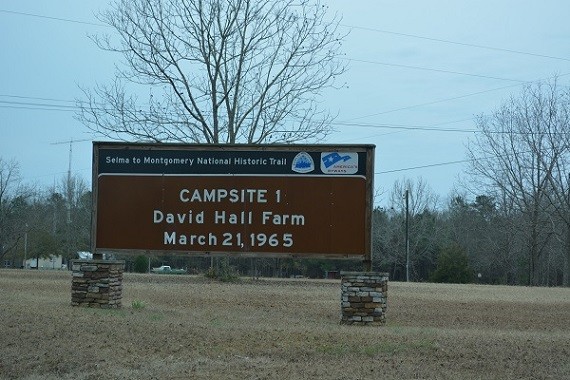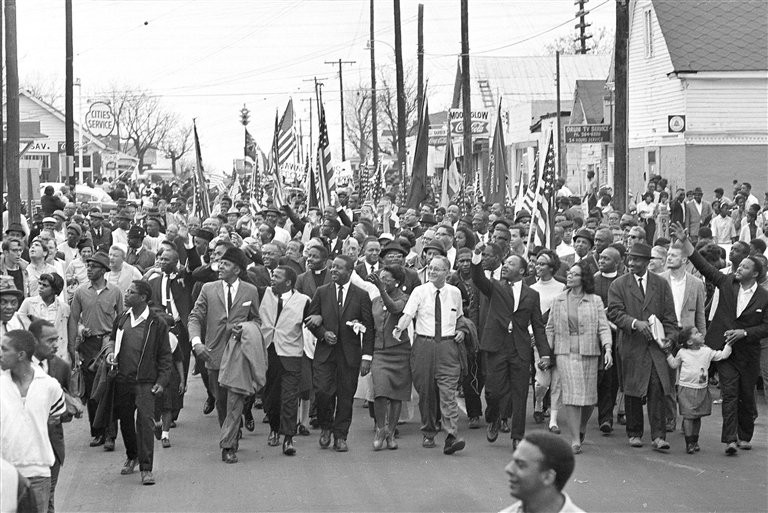David Hall Farm
Introduction
Text-to-speech Audio
This location was used as the first campsite for the activists in the Selma to Montgomery March on the night of March 21, 1965. David Hall, an African American farmer, owned the 80 acre farm in Dallas County, Alabama, and experienced harassment from the locals for assisting the marchers. During their stay here, the marchers got some much needed rest and received medical attention from health professionals for any wounds they got during the first day of the march. The farm is still a private residence to this day and is part of the Selma to Montgomery National Historic Trail.
Images
The David Hall Farm was the first of 4 prearranged campsites used by the marchers on their trek from Selma to Montgomery.

In March of 1965, thousands of people, Black and white, came to Alabama to march for voting rights.

Backstory and Context
Text-to-speech Audio
In 1965 civil rights activists and organizations turned their full attention to voting rights. According to the Fifteenth Amendment of 1870 states cannot deny anyone the right to vote based on the color of their skin. Despite this, southern states still found ways to deter African Americans from voting. Southern whites created literacy tests that they often failed African Americans on, or they threatened any African American with violence and/or death if they attempted to vote. This ongoing and illegal disfranchisement led to the development of a voting rights campaign that escalated into 3 marches from Selma to Montgomery.
After the first two marches to Montgomery failed due to violent altercations, such as the attack on marchers on the Edmund Pettus Bridge on March 7, Martin Luther King Jr. led the third march to Montgomery under federal protection granted by Judge Frank Johnson. The participants and organizers of the march knew they would need safe places to rest during their 54 mile journey from Selma to Montgomery. In response, locations along Highway 80 were pre-arranged to host the marchers during the night over the course of the 5 day march. Most of the campsites were the farms of sympathetic locals along the highway. On March 21, 1965, King led the third march from the Brown Chapel AME Church in Selma, Alabama to the David Hall Farm, where the marchers took time to rest and tend to their wounds after marching approximately 10 miles. The following night they would set up camp at the farm of Rosie Steele.
The sympathy of the locals correlates with the responses of people across the nation after they saw the violence that ensued during the first march on March 7. As people watched news footage of this day they were horrified by the beatings and other assaults that the marchers fell victims to. Disgusted and saddened by the footage, many people outside of the South felt sympathy for the marchers' cause and voluntarily travelled to Alabama to participate in the third march. The march ended in success when the marchers made it to the Alabama State Capitol in Montgomery. The bigger success came on August 6 when President Johnson passed the Voting Rights Act of 1965.
After the first two marches to Montgomery failed due to violent altercations, such as the attack on marchers on the Edmund Pettus Bridge on March 7, Martin Luther King Jr. led the third march to Montgomery under federal protection granted by Judge Frank Johnson. The participants and organizers of the march knew they would need safe places to rest during their 54 mile journey from Selma to Montgomery. In response, locations along Highway 80 were pre-arranged to host the marchers during the night over the course of the 5 day march. Most of the campsites were the farms of sympathetic locals along the highway. On March 21, 1965, King led the third march from the Brown Chapel AME Church in Selma, Alabama to the David Hall Farm, where the marchers took time to rest and tend to their wounds after marching approximately 10 miles. The following night they would set up camp at the farm of Rosie Steele.
The sympathy of the locals correlates with the responses of people across the nation after they saw the violence that ensued during the first march on March 7. As people watched news footage of this day they were horrified by the beatings and other assaults that the marchers fell victims to. Disgusted and saddened by the footage, many people outside of the South felt sympathy for the marchers' cause and voluntarily travelled to Alabama to participate in the third march. The march ended in success when the marchers made it to the Alabama State Capitol in Montgomery. The bigger success came on August 6 when President Johnson passed the Voting Rights Act of 1965.
Sources
"Selma to Montgomery National Historic Trail: PROTESTER CAMPSITES." National Park Planner. Accessed on November 5, 2017.
http://npplan.com/national-historic-trails/selma-to-montgomery-national-historic-trail-trail-at-a-gl...
"Selma to Montgomery National Historic Trail Alabama." nps.gov. Accessed on November 15, 2017. https://www.nps.gov/nr/travel/cultural_diversity/Selma_to_Montgomery_National_Historic_Trail.html
http://npplan.com/national-historic-trails/selma-to-montgomery-national-historic-trail-trail-at-a-gl...
"Selma to Montgomery National Historic Trail Alabama." nps.gov. Accessed on November 15, 2017. https://www.nps.gov/nr/travel/cultural_diversity/Selma_to_Montgomery_National_Historic_Trail.html
